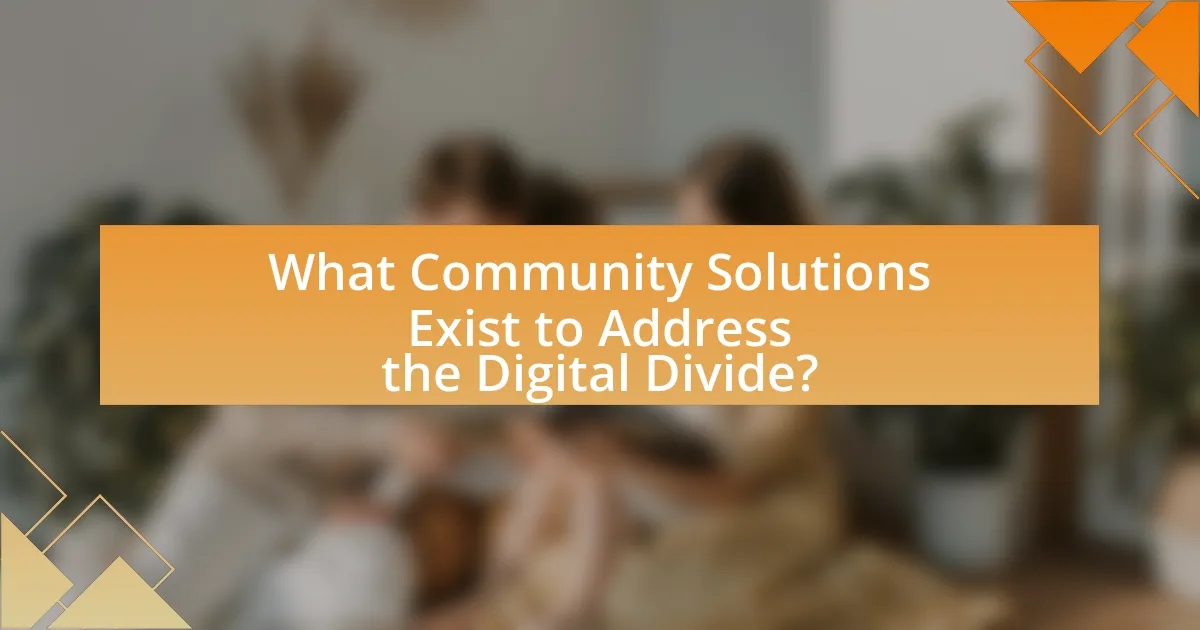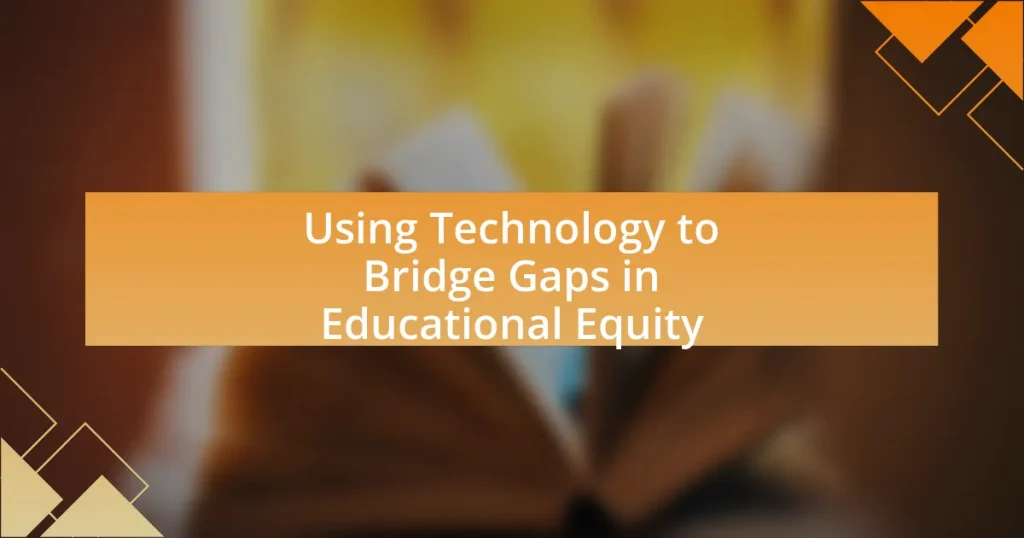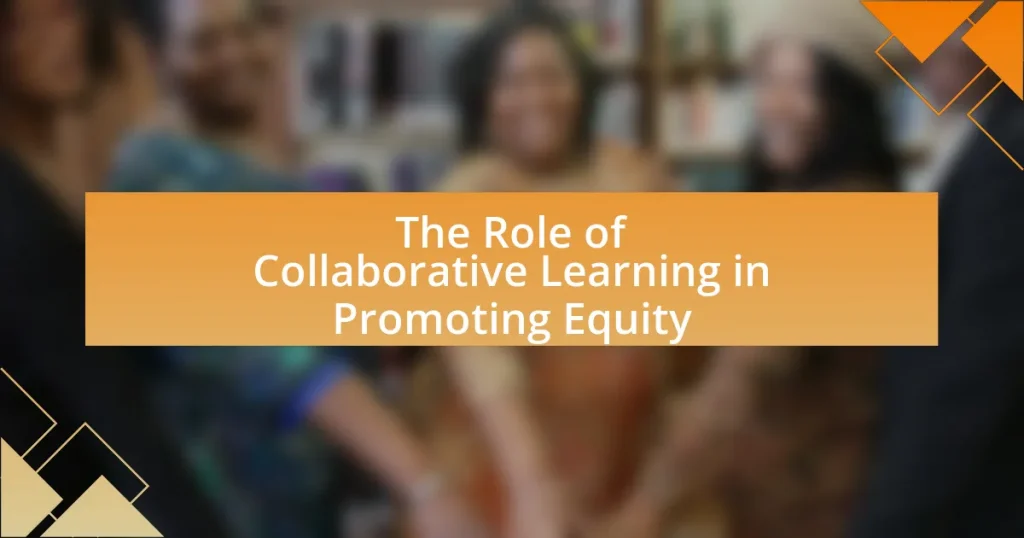The article addresses the Digital Divide, which is the gap between individuals with easy access to digital technology and the internet and those without. It highlights the significant impact of this divide on educational access, particularly for low-income households, where a lack of reliable internet and technology hinders academic performance and opportunities. Key factors contributing to this divide include socioeconomic status, access to technology, and digital literacy. The article also explores community solutions, such as public Wi-Fi programs, digital literacy training, and partnerships with local organizations, aimed at bridging the gap and ensuring equitable access to educational resources. Additionally, it discusses the role of local governments, non-profits, and public libraries in fostering digital learning and improving access to technology for underserved populations.

What is the Digital Divide and Why Does it Matter?
The Digital Divide refers to the gap between individuals who have easy access to digital technology and the internet and those who do not. This divide matters because it affects educational opportunities, economic growth, and social inclusion; for instance, a report by the Pew Research Center in 2021 indicated that 30% of lower-income households with school-age children lacked a reliable internet connection, hindering their ability to participate in remote learning. Addressing the Digital Divide is crucial for ensuring equitable access to resources and opportunities in an increasingly digital world.
How does the Digital Divide impact educational access?
The Digital Divide significantly impacts educational access by creating disparities in technology availability and internet connectivity among different socioeconomic groups. Students from low-income families often lack reliable access to devices and high-speed internet, which hinders their ability to participate in online learning and access educational resources. According to a report by the Pew Research Center, as of 2021, 35% of lower-income households with school-age children reported that they did not have a reliable internet connection, directly affecting their educational outcomes. This lack of access leads to lower academic performance and limits opportunities for skill development, further perpetuating the cycle of inequality in education.
What are the key factors contributing to the Digital Divide in education?
The key factors contributing to the Digital Divide in education include socioeconomic status, access to technology, and digital literacy. Socioeconomic status significantly influences students’ ability to afford devices and internet connectivity, with lower-income families often lacking necessary resources. Access to technology varies widely, as many rural and underserved urban areas have limited broadband infrastructure, hindering students’ online learning opportunities. Additionally, digital literacy is crucial; students and educators must possess the skills to effectively use technology for educational purposes, and disparities in training can exacerbate the divide. According to the Pew Research Center, 35% of lower-income households with school-age children lack high-speed internet, highlighting the impact of socioeconomic factors on educational access.
How does socioeconomic status influence access to digital resources?
Socioeconomic status significantly influences access to digital resources by determining the availability of financial means, infrastructure, and educational opportunities. Individuals from higher socioeconomic backgrounds typically have better access to high-speed internet, personal devices, and digital literacy training, which enhances their ability to utilize online resources effectively. For instance, a report by the Pew Research Center in 2021 indicated that 93% of households earning over $75,000 annually had broadband internet access, compared to only 63% of households earning less than $30,000. This disparity illustrates how lower socioeconomic status can limit access to essential digital tools and resources, thereby exacerbating educational inequalities.
What are the consequences of the Digital Divide on students?
The consequences of the Digital Divide on students include limited access to educational resources, which negatively impacts their learning outcomes. Students without reliable internet or technology face challenges in completing assignments, participating in online classes, and accessing digital learning tools. Research indicates that students from low-income families are disproportionately affected; for instance, a report by the Pew Research Center found that 35% of lower-income households with school-age children lacked high-speed internet access, hindering their academic performance. This disparity can lead to lower grades, decreased engagement, and ultimately, reduced opportunities for higher education and career advancement.
How does limited access to technology affect learning outcomes?
Limited access to technology negatively impacts learning outcomes by restricting students’ ability to engage with educational resources and tools. Research indicates that students without adequate technology access often experience lower academic performance, as they miss out on essential digital literacy skills and online learning opportunities. For instance, a study by the Pew Research Center found that 35% of lower-income students reported not having access to a computer at home, which correlates with decreased homework completion rates and lower grades. This lack of access creates disparities in educational achievement, hindering overall learning and future opportunities for these students.
What role does digital literacy play in educational success?
Digital literacy is essential for educational success as it enables students to effectively navigate, evaluate, and create information using digital technologies. Research indicates that students with strong digital literacy skills perform better academically, as they can access online resources, collaborate with peers, and engage in interactive learning environments. For instance, a study by the Pew Research Center found that 87% of teachers believe that digital literacy is crucial for students’ future success, highlighting its importance in modern education.

What Community Solutions Exist to Address the Digital Divide?
Community solutions to address the digital divide include initiatives such as community Wi-Fi programs, digital literacy training, and partnerships with local organizations to provide access to technology. Community Wi-Fi programs, like those implemented in cities such as San Francisco, offer free internet access in public spaces, helping low-income residents connect online. Digital literacy training programs, often run by libraries or non-profits, equip individuals with essential skills to navigate the internet and use digital tools effectively. Additionally, partnerships with organizations like EveryoneOn facilitate access to affordable devices and internet service for underserved populations, demonstrating a collaborative approach to bridging the digital gap. These solutions are crucial in ensuring equitable access to educational resources and opportunities in the digital age.
How can local governments contribute to bridging the Digital Divide?
Local governments can bridge the Digital Divide by implementing policies that enhance internet access and digital literacy programs. They can invest in infrastructure development, such as expanding broadband networks to underserved areas, which is crucial since approximately 19 million Americans lack access to high-speed internet, according to the Federal Communications Commission. Additionally, local governments can partner with educational institutions and community organizations to provide training programs that improve digital skills, ensuring that residents can effectively use technology for educational and employment opportunities. By prioritizing these initiatives, local governments play a vital role in fostering equitable access to digital resources.
What initiatives have proven effective in increasing internet access?
Community broadband initiatives have proven effective in increasing internet access. These initiatives, often spearheaded by local governments or non-profit organizations, focus on building and maintaining high-speed internet infrastructure in underserved areas. For example, the city of Chattanooga, Tennessee, implemented a municipal broadband network that provides gigabit-speed internet to residents, resulting in increased connectivity and economic growth. Additionally, programs like Google Fiber have expanded access in select urban areas, demonstrating that competitive pricing and infrastructure investment can significantly enhance internet availability. Studies indicate that such community-driven efforts can reduce the digital divide by providing affordable and reliable internet options to low-income households.
How can public libraries serve as community hubs for digital learning?
Public libraries can serve as community hubs for digital learning by providing access to technology, offering digital literacy programs, and creating collaborative learning spaces. These libraries often equip patrons with computers, high-speed internet, and other digital resources, which are essential for bridging the digital divide. According to the American Library Association, over 90% of public libraries offer free internet access, making them vital for individuals who lack connectivity at home. Additionally, libraries frequently host workshops and classes focused on digital skills, helping community members enhance their technological proficiency. This combination of resources and educational opportunities positions public libraries as essential centers for fostering digital learning within communities.
What role do non-profit organizations play in addressing educational access?
Non-profit organizations play a crucial role in addressing educational access by providing resources, support, and advocacy to underserved communities. These organizations often implement programs that offer tutoring, scholarships, and technology access, which directly help bridge the educational gap. For instance, according to the National Center for Education Statistics, non-profits like Teach For America have placed thousands of teachers in low-income areas, significantly improving educational outcomes. Additionally, organizations such as the Boys & Girls Clubs of America provide after-school programs that enhance learning opportunities for youth in disadvantaged neighborhoods. Through these initiatives, non-profits effectively contribute to increasing educational access and equity.
What programs have been successful in providing technology to underserved communities?
Programs such as EveryoneOn, PCs for People, and the Digital Equity Initiative have successfully provided technology to underserved communities. EveryoneOn connects low-income families with affordable internet service and devices, facilitating access to digital resources. PCs for People refurbishes computers and distributes them to low-income individuals, enhancing their ability to engage with technology. The Digital Equity Initiative, launched by various local governments, aims to bridge the digital divide by providing training and resources to underserved populations, ensuring they can effectively use technology for educational and employment opportunities. These programs have demonstrated measurable impacts, such as increased internet access and improved digital literacy among participants.
How can partnerships between schools and community organizations enhance access?
Partnerships between schools and community organizations enhance access by providing resources, support, and opportunities that schools may lack. These collaborations can facilitate access to technology, internet services, and educational programs, which are essential for bridging the digital divide. For instance, community organizations often have established networks and funding sources that can be leveraged to provide students with devices and internet connectivity, thereby improving their ability to engage in digital learning. Research indicates that schools partnering with local nonprofits can increase student participation in after-school programs by 30%, demonstrating the effectiveness of such collaborations in enhancing educational access.

What Best Practices Can Communities Implement for Sustainable Solutions?
Communities can implement best practices for sustainable solutions by fostering collaboration among stakeholders, promoting digital literacy, and ensuring equitable access to technology. Collaborative efforts, such as partnerships between schools, local governments, and non-profits, can enhance resource sharing and create comprehensive educational programs. For instance, initiatives like community tech hubs provide access to devices and internet connectivity, which are essential for bridging the digital divide. Furthermore, promoting digital literacy through workshops and training sessions equips individuals with the necessary skills to utilize technology effectively. According to a report by the Pew Research Center, communities that prioritize these practices see improved educational outcomes and increased participation in the digital economy.
How can communities foster digital literacy among students and families?
Communities can foster digital literacy among students and families by implementing targeted educational programs and providing access to technology. For instance, local libraries and community centers can offer workshops that teach essential digital skills, such as internet navigation, online safety, and software usage. According to a report by the Pew Research Center, 73% of parents believe that digital literacy is crucial for their children’s future success, highlighting the importance of community involvement in this area. Additionally, partnerships with schools can facilitate after-school programs that focus on hands-on learning with technology, ensuring that both students and their families are equipped with the necessary skills to thrive in a digital world.
What training programs are effective in improving digital skills?
Effective training programs for improving digital skills include online courses, workshops, and community-based initiatives. Online platforms like Coursera and edX offer structured courses on various digital skills, while local community centers often provide hands-on workshops tailored to specific demographics. Research indicates that programs integrating practical applications, such as coding boot camps and digital literacy classes, significantly enhance participants’ competencies. For instance, a study by the Pew Research Center found that individuals who completed digital skills training reported increased confidence and proficiency in using technology.
How can mentorship programs support students in navigating technology?
Mentorship programs support students in navigating technology by providing personalized guidance and resources tailored to individual learning needs. These programs connect students with experienced mentors who can offer insights into effective technology use, troubleshooting, and digital literacy skills. Research indicates that mentorship can enhance students’ confidence and competence in using technology, as evidenced by a study from the National Mentoring Partnership, which found that mentored students are 55% more likely to enroll in college and 78% more likely to volunteer regularly in their communities. This demonstrates that mentorship not only aids in technology navigation but also fosters broader educational and social engagement.
What strategies can be employed to ensure long-term access to technology?
To ensure long-term access to technology, communities can implement strategies such as establishing public-private partnerships, investing in infrastructure, and promoting digital literacy programs. Public-private partnerships can leverage resources and expertise from both sectors, as seen in initiatives like the ConnectHome program, which aims to provide broadband access to low-income families in the U.S. Investing in infrastructure, such as expanding broadband networks in underserved areas, is crucial; for instance, the Federal Communications Commission reported that expanding broadband access can significantly improve educational outcomes. Additionally, promoting digital literacy programs equips individuals with the necessary skills to utilize technology effectively, as evidenced by studies showing that increased digital literacy correlates with better job opportunities and economic mobility.
How can community engagement be leveraged to sustain digital initiatives?
Community engagement can be leveraged to sustain digital initiatives by fostering collaboration between local stakeholders, including schools, businesses, and residents, to create a supportive ecosystem. This collaboration can lead to shared resources, such as funding, expertise, and infrastructure, which are essential for the longevity of digital projects. For instance, initiatives like community broadband programs have shown that when local entities work together, they can effectively address connectivity issues, as evidenced by the success of the Chattanooga Gigabit project, which resulted in increased internet access and economic growth in the area. Engaging the community also ensures that digital initiatives are tailored to meet local needs, enhancing user adoption and ongoing participation, which are critical for sustainability.
What funding sources are available to support ongoing digital access projects?
Funding sources available to support ongoing digital access projects include federal grants, private foundations, and corporate sponsorships. Federal grants such as those from the National Telecommunications and Information Administration (NTIA) provide financial assistance specifically aimed at expanding broadband access. Private foundations like the Bill & Melinda Gates Foundation offer funding for initiatives that enhance digital literacy and access in underserved communities. Additionally, corporations often engage in corporate social responsibility programs that allocate funds to support digital access projects, exemplified by tech companies investing in local infrastructure improvements. These funding sources are critical for bridging the digital divide and ensuring equitable access to technology in education.
What are practical steps communities can take to address the Digital Divide?
Communities can address the Digital Divide by implementing initiatives such as expanding broadband access, providing digital literacy training, and establishing community technology centers. Expanding broadband access involves collaborating with internet service providers to ensure affordable and reliable internet service reaches underserved areas; for instance, the Federal Communications Commission reported that approximately 19 million Americans lack access to high-speed internet. Providing digital literacy training equips individuals with the skills necessary to navigate technology effectively, which can be facilitated through workshops and partnerships with local schools or libraries. Establishing community technology centers offers a physical space where residents can access computers and the internet, fostering an environment for learning and collaboration. These steps collectively enhance educational access and bridge the gap in digital resources within communities.



